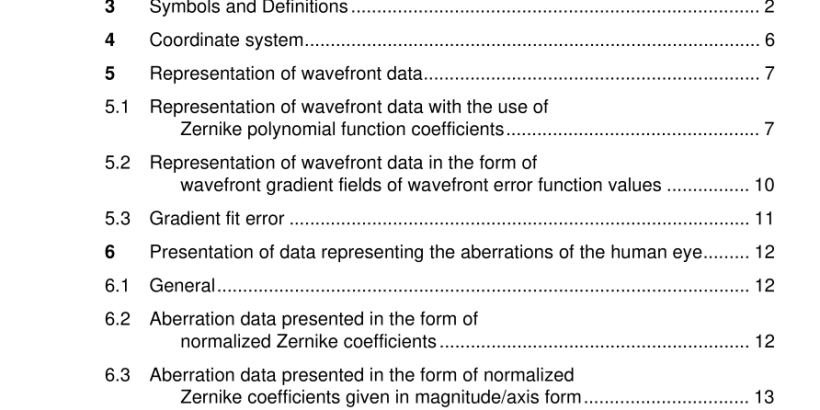ANSI Z80.28-2017 pdf download.Methods for Reporting Optical Aberrations of Eyes
3.4 Wavefront error – W(x,y) or W(r, θ ) The wavefront error of an eye is the optical path-length (i.e., physical distance times refractive index) between a plane wavefront in the eye’s entrance pupil and the wavefront of light exiting the eye from a point source on the retina. It is specified as a function (wavefront error function) of the (x,y) or (r,q) coordinates of the entrance pupil. Wavefront error is measured in an axial direction (i.e., parallel to the z-axis defined in clause 4) from the pupil plane towards the wavefront. By convention, the wavefront error is set to zero at the pupil center by subtracting the central value from values at all other pupil locations. Wavefront error has physical units of meters (typically reported in micrometers) and pertains to a specified wavelength.
3.5 Optical path-length difference – OPD The optical path-length difference at each point in a wavefront is the negative of the wavefront error (3.4). It represents the correction of the optical path length needed to correct the wavefront error.
3.6 Root mean square wavefront error (RMS error) The root mean square wavefront error for the eye is computed as the square root of the variance of the wavefront error function (3.4). Piston and average tilt should be excluded from this calculation because they correspond to lateral displacements of the image rather than image degradation per se.
NOTE: The RMS error may also be found using the discrete set of wavefront error values that were used to generate the Zernike coefficients and standard statistical methods. When this is done, it may be found that this RMS value does not exactly match the value found using the formula given above. This is more likely to happen is cases where the locations in the pupil used to sample the wavefront error form a nonuniformly spaced grid. Then the data set does not lead to the formation of discrete, orthogonal Zernike functions.
3.7 Higher order aberrations Higher order aberrations of the eye refer to those aberrations that are in addition to sphero-cylindrical refractive errors and prismatic error. If the wavefront error is expressed in terms of Zernike polynomial function coefficients, the higher order aberrations are those of order 3 and higher.
4. Coordinate system
The coordinate system used to represent wavefront surfaces shall be the standard ophthalmic coordinate system as per ISO 8429:1986 in which the x axis is local horizontal with its positive sense to the right as the examiner looks at the eye under measurement, the y axis is local vertical with its positive sense superior with respect to the eye under measurement, the z axis is the line of sight of the eye under measurement with its positive sense in the direction from the eye toward the examiner. The horizontal and vertical origin of the coordinate system is the center of the visible pupil of the eye. The coordinate system origin lies in the plane of the exit pupil of the eye (for light originating on the retina and passing out through the pupil). This coordinate system is illustrated in Figure 1. The sign convention used for wavefront error values reported at any location on a wavefront shall be that used for this coordinate system. When Zernike coefficients are used to represent a wavefront or to report wavefront error, the sign convention used to describe the individual Zernike functions shall be that used for this coordinate system.ANSI Z80.28-2017 pdf download
